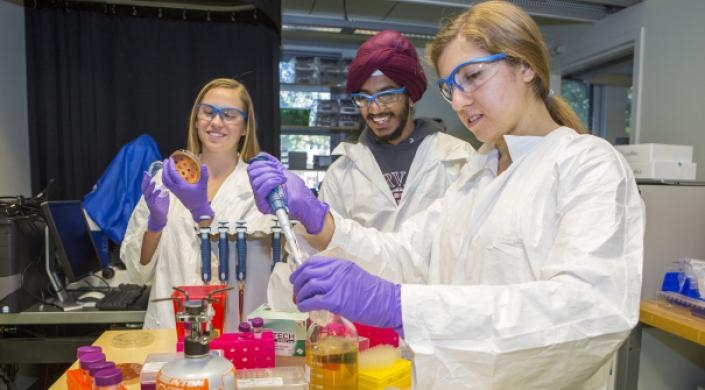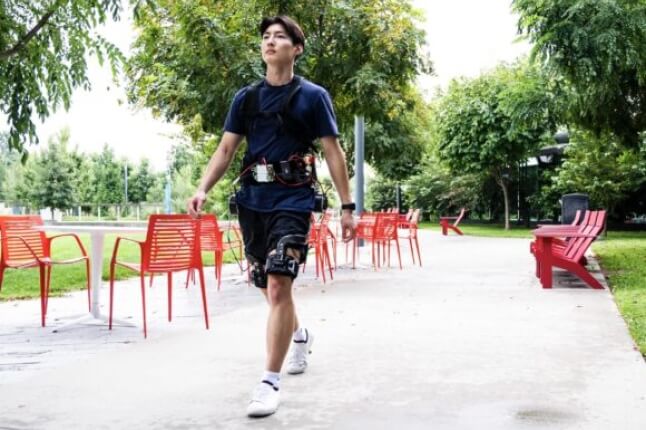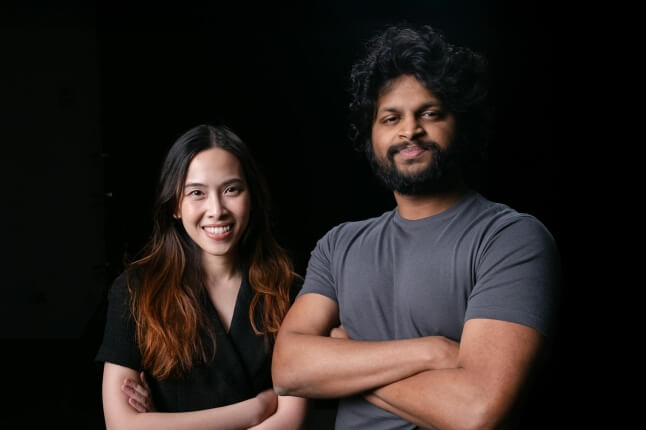News
Students (from left) Rebecca DePew, A.B. '16, Kaitavjeet Chowdhary, A.B. ’17, and Velina Kozareva, A.B. '16, collaborate on a project inside the new microbial engineering laboratory at SEAS. (Photo by Eliza Grinnell.)
Potentially lethal microbial biofilms are responsible for approximately 1.7 million hospital-acquired infections in the U.S. each year, according to the Centers for Disease Control and Prevention.
But a growing area of research has shown that biofilms— bacterial communities stuck together with clumps of sugar and protein—could also have a number of beneficial uses, from powering an automobile to cleaning up a chemical spill.
Students at the Harvard John A. Paulson School of Engineering and Applied Sciences (SEAS), are now getting hands-on experience in this burgeoning area of genetic engineering in the school’s new bioengineering laboratory. The lab, which opened in September, is the newest addition to the Active Learning Labs at SEAS, which provide hands-on engineering experience for students.
“The opening of this new laboratory emphasizes the commitment among SEAS leadership and faculty to support the Active Learning Labs,” said Anas Chalah, executive director of active learning. “This project involved high levels of collaboration between faculty, leadership, and administration to develop the vision and execute the plans to complete this lab in record time.”
The first student laboratory at SEAS dedicated to microbial engineering, the space enables students enrolled in Cellular Engineering (BE-121) to conduct intricate bacterial manipulation projects, said instructor Neel Joshi, associate professor of chemical and biological engineering. Joshi’s students manipulate the DNA of the nanofibers attached to Escherichia coli bacteria biofilms. By altering the biofilm’s cellular function, students can control what the bacteria adhere to, immobilize enzymes the bacteria produce, or change the way bacteria interact with their surroundings.
“Bacteria are relatively easy to manipulate genetically. We can write complex programs and then engineer bacteria to implement those programs,” Joshi said. “The fields of synthetic biology and microbial engineering are booming right now, so it is great to have this kind of work represented at SEAS.”
The new lab contains polymerase chain reaction thermocyclers and a refrigerated centrifuge that enable synthetic biology experiments to be conducted at very specific temperatures, explained Sara Hamel, environmental and biological lab engineer.
“We are now able to teach students the main lab protocols and the theories behind those protocols—the same steps for working in any medical research lab,” said Hamel. “They are getting hands-on experience that will really help them thrive, whether they go on to graduate school or go to work in the biomedical field.”
And there is growing interest in the biomedical field within SEAS—enrollment in the lab portion of Joshi’s course doubled this year. Since the biomedical engineering concentration was introduced at SEAS in 2010, the number of concentrators has steadily increased to more than 50.
Bioengineering concentrator Rebecca DePew, A.B. ’16, is looking forward to using the lab to design her own biofilm experiment for the course’s final project.
“I’m excited to get some hands-on lab experience and learn about what is on the cutting edge of genetic engineering,” she said. “It is interesting to be able to learn about bacteria and genetics in the classroom, and then actually see those processes in action.”
For chemical and physical biology concentrator Kaitavjeet Chowdhary, A.B. ’17, the lab work emphasizes the intricate nature of genetic engineering.
“We spend a lot of time talking about how these processes work—how you would insert a piece of DNA—but there are a lot more considerations you might not take into account when you are just talking about an experiment,” he said.
Now that SEAS has dedicated active learning space for microbial engineering, Joshi is planning to offer a “boot camp” during January term for students interested in genetically engineered microbes. The lab could also provide resources for Harvard student teams participating in the International Genetically Engineered Machine (iGEM) competition, which challenges teams of students from around the world to develop synthetic biology projects. This year’s Harvard iGEM team took home a gold medal at the competition, and Joshi is hopeful that the new lab space will encourage even more students to participate.
Topics: Bioengineering
Cutting-edge science delivered direct to your inbox.
Join the Harvard SEAS mailing list.
Press Contact
Adam Zewe | 617-496-5878 | azewe@seas.harvard.edu



